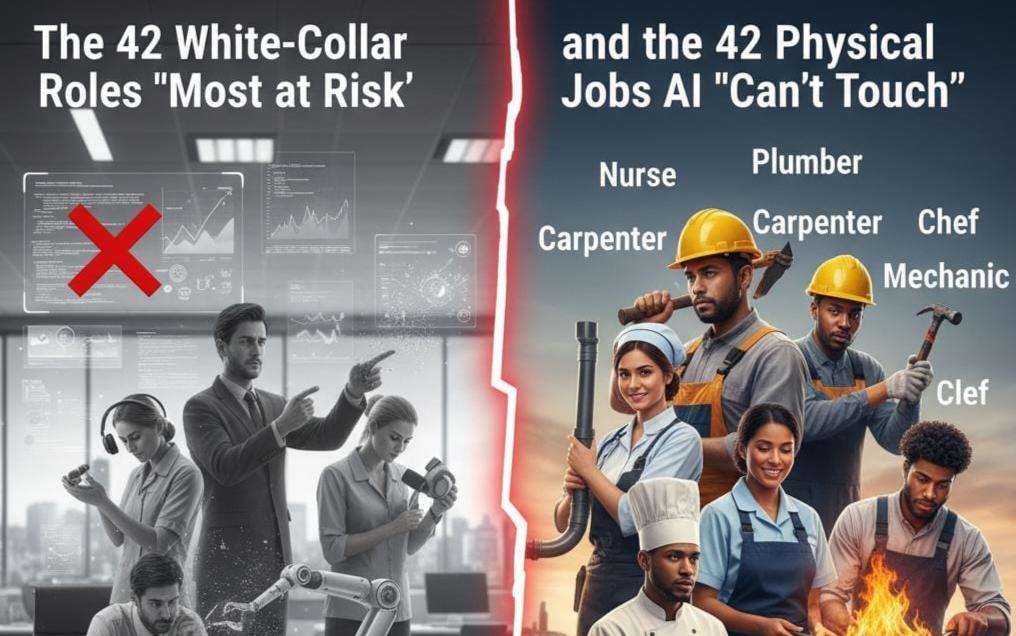The quiet revolution is now a mass displacement event for the office worker. Writer Joe Turner, 38, lost over $150,000 (£120,000) and 70% of his clients in two years, not to a competitor, but to a computer. His story is the starkest warning yet of a new digital divide, where 42 knowledge-based jobs are demonstrably 'most at risk' of automation, while a contrasting 42 roles requiring physical presence and human touch remain effectively 'AI-proof.'
"It's a betrayal," says Turner, whose financial world collapsed after his clients simply substituted his creative work for a chatbot. "You get replaced by a machine."
The Digital Erasure: 42 Knowledge Jobs Under Threat
A major Microsoft study, based on analysing 200,000 conversations with its Co-Pilot chatbot, quantified the exposure. It assigned high-risk scores to any role dominated by information processing, routine communication, data analysis, and code generation—the very tasks Generative AI excels at.
AI could perform 98% of the tasks for Interpreters and Translators and around 90% for professions like Historians and Entry-level Coders/Programmers. The core functions of Writers, Journalists, and Technical Authors are all flagged as highly exposed, alongside administrative support roles like Telephone Operators and Customer Service Representatives (72% exposure).
In the finance and analysis sectors, Accountants and Auditors are now clearly on the list due to the ease of automating data entry and compliance checks. Other highly vulnerable roles include Data Scientists, Market Research Analysts, Web Developers, Personal Financial Advisors, and various clerical and teaching positions such as Postsecondary Economics Teachers and Concierges.
As AI researcher Xinrong Zhu notes, jobs like these are "most likely to be replaced entirely by the tool," a verdict echoed by corporate actions: Klarna cut 40% of its workforce after investing in AI, and major tech giants like Microsoft and Amazon are pairing large-scale layoffs with massive AI investments.
The Human Fortitude: 42 Physical Jobs AI Can't Touch
In contrast to the digital purge, roles requiring complex physical dexterity, non-routine manual labour, critical physical-world judgment, and deep emotional intelligence boast minimal AI exposure.
Tradespeople are the clearest winners. Jobs like Roofers (2% exposure), Painter-Decorators (4%), and Plumbers—who perform complex spatial problem-solving with their hands—are practically untouched. Manual operators, including Dredge Operators, Pile Driver Operators, and Highway Maintenance Workers, are also secure, as is anyone performing physical maintenance like Ship Engineers.
Healthcare and Personal Services form another safe bloc. Roles like Orderlies (0% exposure), Nursing Assistants (7%), Surgical Assistants, and Phlebotomists demand a human touch and critical, moment-to-moment bedside judgment that AI cannot provide. Even niche roles such as Embalmers, Prosthodontists, and Massage Therapists are protected by the necessity of physical presence and manual skill.
Daily Dazzling Dawn Analysis: The Future-Proof Shift
The evidence points to a rapid acceleration of job transformation, not just displacement. Predictions from experts like former Google CEO Eric Schmidt suggest AI could displace 50% of white-collar entry-level jobs within five years, creating a painful economic "drought" before new roles emerge.
The Past: Jobs Poised to Vanish for AI (Near Future)
The first jobs to disappear completely will be those defined by highly repetitive digital tasks and scripted interactions:
- Data Entry Clerks: Virtually 100% automatable by machine learning pipelines.
- Telemarketers: Replaced by sophisticated voice AI and automated lead generation.
- Bank Tellers/New Accounts Clerks: Routine transactions and paperwork are easily digitized.
- Receptionists/Switchboard Operators: Replaced by automated check-in systems and virtual assistants.
- Proofreaders/Basic Editors: Large Language Models are becoming nearly flawless in grammar and style checks, making these roles redundant.
The Future: Emerging Roles on the AI-Safe List
The future economy is creating new, highly-paid roles that focus on the vital human-machine interface. These roles, often paying up to 23% more than traditional jobs, require uniquely human skills to manage and direct AI:
- Prompt Engineer: The highly-valued skill of crafting instructions to extract optimal results from AI models.
- AI Auditor/Ethicist: Professionals needed to ensure AI systems are fair, transparent, and compliant with new global regulations.
- Generative AI Designer: Using AI tools for rapid creative prototyping, where human creativity and artistic curation remain essential.
- Robotics Engineer/Technician: The people who build, maintain, and repair the physical machines controlled by AI.
The critical insight for survival is simple: Embrace augmentation, not fear replacement. Workers who integrate AI skills into their profiles are already securing higher salaries and better career prospects. However, the one true safe bet remains the resilience, complex judgment, and physical capability that define the human worker.








.svg)

_2.jpg)
